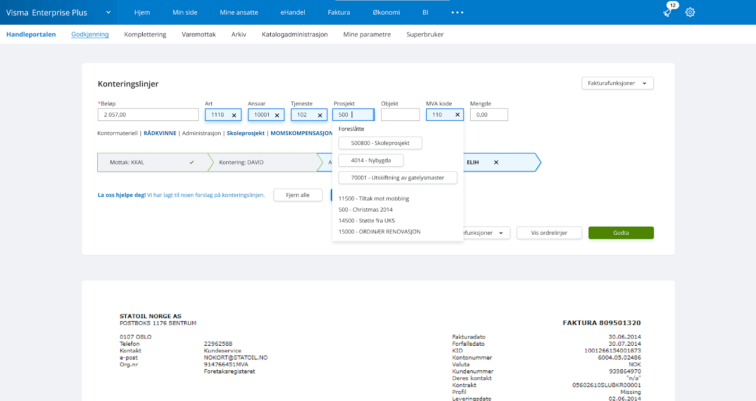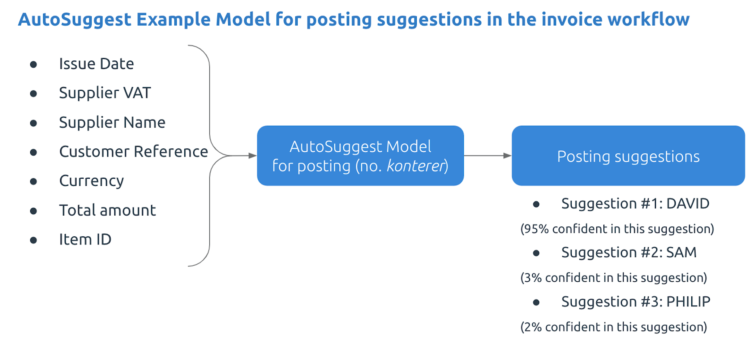In the world of accounting, many valuable hours are spent on manual invoice handling. However, times are changing. Automated invoice handling has made exciting advances, thanks to a recent management trainee project.
For the duration of nine weeks, Management Trainee Henrik Hesle participated in a cross-collaboration project between our Machine Learning Assets team and Visma Enterprise Plus. Visma Enterpise’s proof of concept suggested that machine learning could automate parts of the user’s invoice handling process – and they have decided to implement Henrik’s proposed solution!
Henrik explains: “Invoice handling is a repetitive and tedious task, yet it is crucial to get it right and make sure it is completed on time. Automating this process allows for saving time and resources that can be reallocated to other tasks”.
Invoice handling is a repetitive and tedious task, yet it is crucial to get it right and make sure it is completed on time.
Henrik Hesle, Management Trainee 2021–2022
The project aimed to simulate the amount of work that could be saved in invoice handling by using machine learning. As part of the project, Henrik conducted several experiments to measure the possible degree of automation.
The project showed exciting results, demonstrating high levels of accuracy and reliability. This suggests that machine learning can facilitate several parts of invoice handling, thereby saving users a significant amount of time.
Automating invoice handling in Visma Enterprise
Automated invoice handling is a feature that streamlines the invoice handling process by reducing or eliminating the need for manual tasks. We can enrich the user with information that is not present on the invoice itself but can be inferred. During his project, Henrik modelled the workflow in Visma Enterprise to automate the user’s work and provided suggestions on:
- Who is responsible for each step of the invoice handling process
- Which projects the invoice belongs to
- The cost account
- …and more
In the image below you can see Henrik’s suggestions for the user interface in Visma Enterprise Plus, and ways to demonstrate the machine learning suggestions to the end-user.


Tasks like these are difficult to solve with traditional approaches because there can be so much variation in how human decisions are made. Where traditional approaches struggle with these types of tasks, that is where machine learning thrives. That’s why this project uses AutoSuggest, a machine learning solution developed by the Visma Machine Learning Assets team.
The experiments showed great results with an accuracy of about 85% for invoice handling! This means that by using AutoSuggest, Visma Enterprise is able to streamline the user’s workflow with a high level of accuracy – requiring little interaction from a human.
How AutoSuggest works
The Machine Learning Assets team does the heavy lifting of machine learning and provides easy-to-use solutions to Visma applications. This enables Visma Enterprise to deliver on the promise of artificial intelligence while focusing on their core services.
The image below shows what Visma Enterprise did in order to make use of artificial intelligence. They provided the information displayed on the left to the API. Next, AutoSuggest uses that information to give the user suggestions on which person is responsible for the bookkeeping of the associated invoice.

The future of automated invoice handling
Machine learning approaches are capable of learning complicated patterns if the right data is available for training. A very important part of building the right machine learning is finding the right data, which we use to build our models and train them. Large efforts are being made to obtain quality data to further develop and train the machine learning models. Henrik adds:
“We had meetings with customers during my project, and they were very positive about this feature. They were wondering when this would be available for testing and would like to participate as pilot customers.”
Overall, the future for automated invoice handling is extremely promising and we cannot wait to see what it holds.
Also read: Here are the Management Trainees of 2021-22
Want to do more with automated invoice handling?
The automation workflow can be divided into two separate tasks; extracting invoice information and enriching invoice information.
When invoices and receipts are received in an ERP system, they can have many different structures and file formats. The first task is to extract the relevant information in a structured format so that it can be filled in automatically into the system. The Machine Learning Team offers the industry-leading solution SmartScan, which captures data from documents instantly.
You have already been introduced to AutoSuggest, capable of learning the manual decisions you make, e.g. in your invoice handling and expense workflow.
In addition, you can configure SmartScan to return the full text of a document, which is then the input to AutoSuggest for prediction, e.g. the expense type. Before you get to this point, you already provided training data to AutoSuggest to learn how documents map to, as an example, expense types in your system. If there is customer variation, we train multiple AutoSuggest models.

What the combined system of our machine learning solutions looks like. SmartScan and AutoSuggest can both work as standalone solutions, or complement each other in this way.
These solutions are designed to deliver a fast and intelligent experience that enables the end-users to work more efficiently and make data-driven decisions.
Want to learn more about SmartScan’s technology?
Check out this blog post series.

